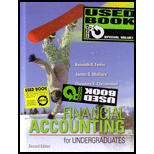
Compute the following ratios
- a) Return on sales
- b)
Current ratio - c) Debt-to-total-assets ratio
- d) Free
cash flows , and
Comment on the trend in Company T’s profitability, liquidity, solvency, and free cash flows.
Explanation of Solution
a) Return on sales ratio: The ratio which evaluates the amount of net income earned for every dollar of net sales is referred to as return on sales ratio.
Compute the return on sales ratio for Company T for the year 2010.
Net income = £2,336 million
Net sales = £56,910 million
Compute the return on sales ratio for Company T for the year 2011.
Net income = £2,671 million
Net sales = £60,931 million
b) Current ratio: Current ratio is one of the
Compute current ratio for Company T for the year 2010.
Current assets = £11,765 million
Current liabilities = £16,015 million
Compute current ratio for Company T for the year 2011.
Current assets = £11,869 million
Current liabilities = £17,731 million
c) Debt to Asset Ratio: Debt to asset ratio is the ratio between total asset and total liability of the company. Debt ratio reflects the finance strategy of the company. It is used to evaluate company’s ability to pay its debts. Higher debt ratio implies the higher financial risk.
Compute debt-to-total-assets ratio for Company T for the year 2010.
Total assets = £46,023 million
Total liabilities = £31,342 million
Compute debt-to-total-assets ratio for Company T for the year 2011.
Total assets = £47,206 million
Total liabilities = £30,583 million
d) Free cash flow: Free cash flow describes the net cash provided from operating activities after making required adjustments for capital expenditures. In other words, it is the cash flow arrived after making payment for capital expenditures.
Compute free cash flow for Company T for the years 2010 and 2011.
| Particulars | 2010 | 2011 |
| In millions | ||
| Cash flow from operating activities | £4,745 | £3,992 |
| Less: Cash investment in property and equipment | 2,855 | 3,178 |
| Free cash flow | $1,890 | $814 |
Table (1)
Comments:
Trends in Company T’s profitability:
- Profitability of Company T is measured by return on sales ratio.
- The ratio is has increased a little from 4.1% in 2010 to 4.4% in 2011.
- This shows that the company’s profitability is stable.
Trends in Company T’s liquidity:
- Liquidity of Company T is evaluated by current ratio.
- The ratio shows a decreasing trend from 0.73 in 2010 to 0.67 in 2011.
- This shows that the capacity to pay for short-term liabilities has decreased.
Trends in Company T’s solvency:
- Liquidity of Company T is measured by debt-to-total assets ratio.
- The ratio shows a decreasing trend from 68.1% in 2010 to 64.8% in 2011.
- This shows that the repaying capacity of the corporation has increased.
Trends in Company T’s free cash flow:
- The computation shows a decreasing trend from £1,890 in 2010 to £814 in 2011.
- But yet Company T has a healthy free cash flow in the years to repay its lenders, pay dividends to stockholders.
Want to see more full solutions like this?
Chapter 4 Solutions
Financial Accounting for Undergraduates

 AccountingAccountingISBN:9781337272094Author:WARREN, Carl S., Reeve, James M., Duchac, Jonathan E.Publisher:Cengage Learning,
AccountingAccountingISBN:9781337272094Author:WARREN, Carl S., Reeve, James M., Duchac, Jonathan E.Publisher:Cengage Learning, Accounting Information SystemsAccountingISBN:9781337619202Author:Hall, James A.Publisher:Cengage Learning,
Accounting Information SystemsAccountingISBN:9781337619202Author:Hall, James A.Publisher:Cengage Learning, Horngren's Cost Accounting: A Managerial Emphasis...AccountingISBN:9780134475585Author:Srikant M. Datar, Madhav V. RajanPublisher:PEARSON
Horngren's Cost Accounting: A Managerial Emphasis...AccountingISBN:9780134475585Author:Srikant M. Datar, Madhav V. RajanPublisher:PEARSON Intermediate AccountingAccountingISBN:9781259722660Author:J. David Spiceland, Mark W. Nelson, Wayne M ThomasPublisher:McGraw-Hill Education
Intermediate AccountingAccountingISBN:9781259722660Author:J. David Spiceland, Mark W. Nelson, Wayne M ThomasPublisher:McGraw-Hill Education Financial and Managerial AccountingAccountingISBN:9781259726705Author:John J Wild, Ken W. Shaw, Barbara Chiappetta Fundamental Accounting PrinciplesPublisher:McGraw-Hill Education
Financial and Managerial AccountingAccountingISBN:9781259726705Author:John J Wild, Ken W. Shaw, Barbara Chiappetta Fundamental Accounting PrinciplesPublisher:McGraw-Hill Education





